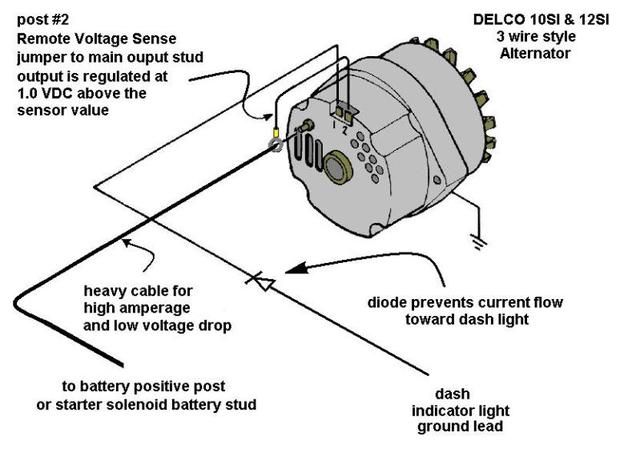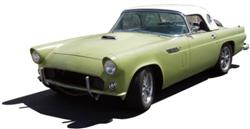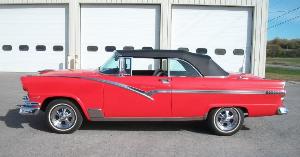|
Group: Forum Members
Last Active: Last Year
Posts: 1.7K,
Visits: 102.7K
|
Here is a three wire GM wired as a "two" - use a No.6 welding cable as the feed to the battery post on the starter solenoid. It has virtually no voltage drop. 
You will find that one of the wires from the voltage regulator goes to the horn relay - another goes to the main harness, back to the dash entry point. Obviously - they will have to be "re-configured". I rigged the "main" to the dash to have a main (maxi)fuse and be tied to the same solenoid post as the alternator.

Steve Metzger Tucson, Arizona
|
|
Group: Forum Members
Last Active: 10 Years Ago
Posts: 281,
Visits: 1.9K
|
There are several advantages to running a three wire alternator over the one wire. If wired correctly of course. 1. warning light (A must in my opinion) 2. adding a diode will stop any chance of running on 3.wiring the sensor wire away from the alternator or at the battery means better charging and higher operating voltage. The ideal voltage is between 13.8v and 14.2v. I had 14.2 after my conversion. (at the battery) From what I can see they are same alternator the true one wire alts have some internal wiring changes. Many people wire the three wire by not using the warning light and connecting the sensor to the output wire. The only advantage that I can see is that for a trailer queen they only have one wire on show. Be cautious of the higher amp alternator as these are pushing the original design a bit too far and can have issues with heat. amps over 100 amp can have belt slippage problems if only a single belt is used. I used a 100amp three wire and have had no trouble. There is probably more charging capability at idle with the new system that what the old had, total. Cheers Warren
 Grizzly (Aussie Mainline) Grizzly (Aussie Mainline)
|
Hitting on all eight cylinders
Group: Forum Members
Last Active: 12 Years Ago
Posts: 18,
Visits: 101
|
I put in a "Powermaster" 1 wire. It is a direct bolt in to the original bracket. I used an oscilliscope to check outputs both before conversion and after. The alternator put out much "cleaner" DC power which was my goal. Any modern electronic upgrades will appreciate cleaner power. Now my headlights don't dim when I slow down to idle at the stop sign. I did put in a larger output wire since the alternator has about twice the potential amperage capacity of the old Jennie, and per the instructions installed a stout ground wire as well. So far I am very happy with the upgrade.
|
|
Group: Forum Members
Last Active: Last Month
Posts: 1.9K,
Visits: 194.9K
|
If you google 3 wire alternator, you'll get some wiring diagrams. The last one I wired was to a custom gauge cluster with a volt meter, so I'm not quite sure about the "idiot" light. You've got a large terminal that's the output. Two spade types, adjacent to each other. One goes to the battery, regulating the voltage to supply rated (or regulated) voltage at the battery. Depending on wire size, distance resistance, this will be less than at the alternator terminal. That's what happened to me. Big deal if the battery is in the trunk. The other runs the light. I think in a one wire, they have a plug that jumps the two together, or has one wire that jumps to the output wire. I like the battery to see the full regulated voltage, about 13.7, rather than run lower. I also like a light, even with a voltmeter, if it's part of the dash panel.
There's a caution on some diagrams NOT to run the sensor wire off the coil, or something on the "off" side of the ignition switch. When you turn the car off, the alternator feeds the coil, and the car keeps running. They're right, don't ask how I know.
Hard to say without seeing the wiring, but I'd bet something like this, and the jumper, is what killed the battery at cruise night on the one wire. If you take the time to look at the diagrams, it breaks down to really simple, and just works.
I've never had it happen on a GM (I learned), but the first time I replaced a generator with an alternator, I wired it wrong, and it wouldn't charge until the engine saw 3000rpm. No current to the unit, but enough residual magnetism (so I was told)' to "self energize". I think it was a Marchal unit, back around 1970. Having used Lucas, I'm more inclined to believe internal leakage. Hope this helps, but check the diagrams, my memory isn't what it used to be.
miker
55 bird, 32 cabrio F code
Kent, WA
Tucson, AZ
|
|
Group: Forum Members
Last Active: 4 days ago
Posts: 3.7K,
Visits: 32.6K
|
A fellow restoring a Crown Vic got it on the road last week.He used a one wire alternator.First cruise nite the battery was dead at nites end.It drained back through the alternator.Defective alternator I guess.
 
|
|
Group: Forum Members
Last Active: Yesterday
Posts: 3.6K,
Visits: 497.7K
|
I understand that the 3 wire is more easily attainable from the parts stores. I run a 3 wire on my 54 Ford.
54 Victoria 312; 48 Ford Conv 302, 56 Bird 312
Forever Ford
Midland Park, NJ
|
|
Group: Forum Members
Last Active: 2 Years Ago
Posts: 279,
Visits: 4.0K
|
I like the generator light, and it's my understanding that you need the three wire for the light. I also have a voltmeter, but the light catches my attention first.
Don
|
|
Group: Forum Members
Last Active: Last Month
Posts: 1.9K,
Visits: 194.9K
|
Opinions vary. I did my first 1 wire conversion on my bird some 12 years ago, and found a noticeable voltage drop from the alt output to the battery. With new wires. The 3 wire solved it, and I've never done anything but 3 wire since.
miker
55 bird, 32 cabrio F code
Kent, WA
Tucson, AZ
|
|
Group: Forum Members
Last Active: 12 Years Ago
Posts: 28,
Visits: 59
|
Hello all. Well, the regulator died in the 55 Bird and in turn, smoked the generator I believe  . So, been reading and reading on alternator conversions. Obviously the GM 1Wire is the quickest and easiest. However, seems the 3Wire would be a better option. Just wondering who has done this on a 55 Bird or I guess pass car? Just needing some insight on how to wire the 3Wire option up in the old Bird. Look forward to some ideas. Thanks!
|